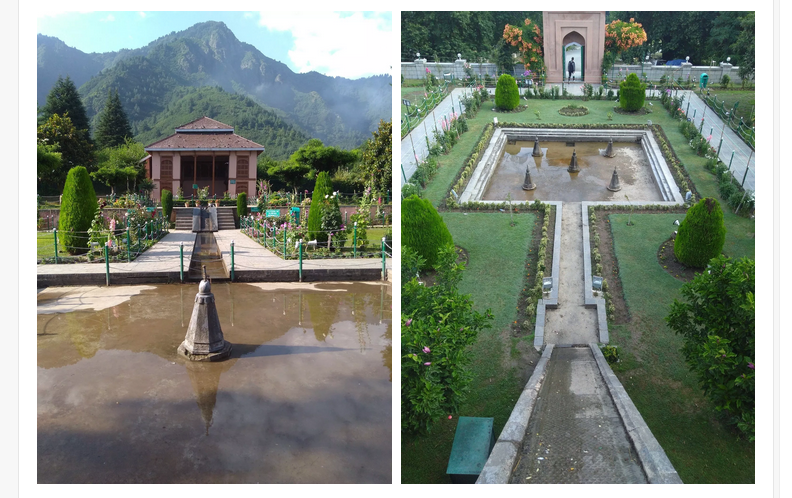Chashme Shahi was completed in 1632 (making it a cool 368 years old!) on the orders of Shah Jahan as a gift for Dara Shikoh his eldest son.
It’s a quiet morning, early for the place I have arrived at. The trinket, food shops and ticket counter with a prominent mention of GST are all closed. There is a slight nip in the air, it is a fresh morning and I have a comfortable hour to explore a little gem – Chashme Shahi Bagh. It is the only Bagh open early, that is before its official opening as the locals access the spring to collect water I am told. For now there is no one except an arched gateway at the top of a steep flight of stairs. I step out, or rather step up the steep stairs made of finely hewn stone.
Chashma, spring in Kashmiri, was originally discovered by Kashmiri Saint Rupa Bhawani, whose family name was ‘Sahib’, and the spring was originally called ‘Chashme Sahibi’ which over the years got corrupted to Chashme Shahi meaning the Royal Spring. Located in the Zabarwan range, it continues to retain the natural spring and has outstanding views of the Dal.
Chashme Shahi was completed in 1632 (making it a cool 368 years old!) on the orders of Shah Jahan as a gift for Dara Shikoh his eldest son. Inspired by the Persian pleasure gardens including that of Humayum’s Tomb (dated 1570) it is a wee bit senior to the Taj Mahal, whose building started the year Chashme Shahi was completed. It is the smallest of Mughal Gardens in Srinagar, the better-known ones being Shalimar and Nishat. Oriented north-south, it is approximately 1.7 acres with a width of about 70 m and length of about 120 m. The Chashme Shahi, makes good use of the fact that it is located at some height on fairly steep slope by organizing itself in 3 descending terraces, with a single central axis, interspersed with a series of shallow square shaped water cisterns with fountains, the level difference being accommodated in steep chadars/ cascades. The fish scale pattern in the stone surface of the chadar creates ripples in the water that catch and shimmer the morning Himalayan sun. I was early for the fountains, the water flow overnight was chanelled into some underground channel and the water cisterns were just getting filled up, I guess the fountains go on once the ticket sales start. The head provided by the steep terrain perhaps makes the hydraulics of the fountains easier than some of the flatter terrained gardens. The spring itself is covered by a small neat dome, out of which water flows continually through a central lip like projection and the mouth of two beautifully carved fish, perhaps inspired by a local fish species (I couldn’t find anything on the web, nor did an enquiry with fish experts yield anything specific) on either side into a small shallow tank. This assemblage is housed in an elegant pavilion.
The Chashme Shahi along with 5 other Mughal Gardens has been on the tentative list of UNESCO World Heritage Sites since 2010, with seemingly no attempt being made by the state authorities to submit a dossier for an actual listing. Reading the tentative list description on the UNESCO World Heritage Site (https://whc.unesco.org/en/tentativelists/5580/) is heart rending, I recommend you read the ‘Justification of Outstanding Universal Value’ section. It unfortunately gives one a sense of what we are losing. In an article by journalist Naveed Iqbal in the Indian Express dated June 10, 2018, Dr Priyaleen Singh is quoted, “The Mughal Gardens have been reduced to municipal parks … earlier … they made a demand on all five senses, while today’s experience of being in the gardens is very bland, like lawns,”.
Chashme Shahi, perhaps because of its smaller size and slightly more remote location still seems to have retained more character and I hope that the Government of J&K will rise upto the task.
As I spend time at the spring mouth I can’t help but notice the important messages printed in white on blue and green flex boards, ‘Don’t Pluck Flowers’, a stern one reads, ‘Washing of Feet and entering spring area is strictly prohibited By order h’ble High Court’ that mar the elegance. The Pigeons are oblivious to these signboards and seem to be enjoying the water the most. While most were quenching their thirst and generally hanging around, a few were quite particular about their early morning bath before the days work, quite enjoying the chilled water.
A man appears from somewhere on the right of the spring, he is carrying a plastic water bottle, we chat. He works here, people come to fill water from this spring for its special properties he tells me as he fills his bottle. I can see a small army tent at the other end and can hear a South Indian accented Hindi, a man in army fatigues comes with a jerry can, this probably is their days water supply. Defying the High Court order I too dip my hand in the flowing water, it is cold and refreshing.

















